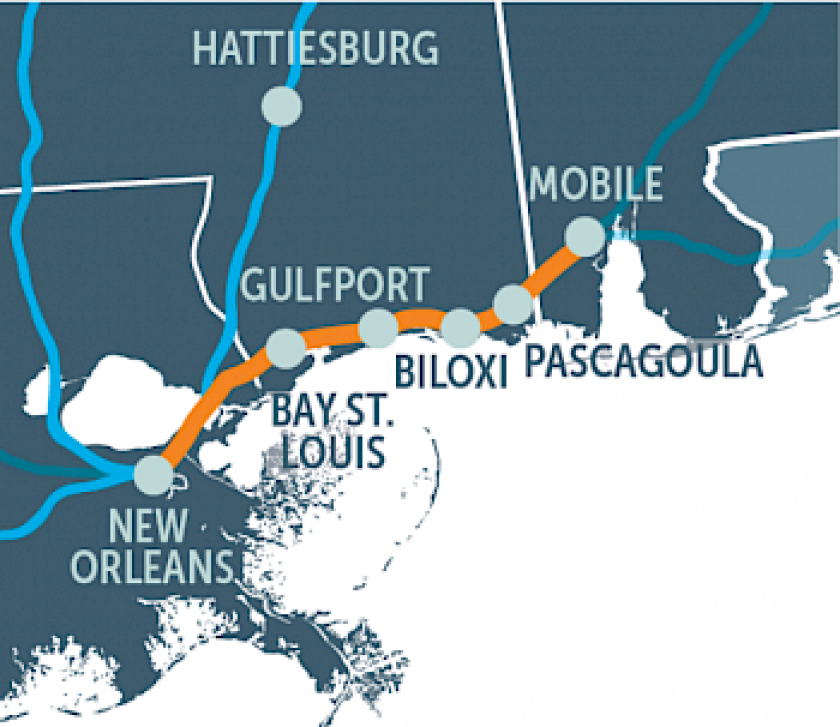Earlier this week, a deadline for mediation in a case pending before the Surface Transportation Board (STB), a federal agency, quietly elapsed. The case, which revolves around Amtrak’s goal of providing twice-a-day, round-trip service between Mobile and New Orleans, has been seen as a test of Amtrak’s ability to expand and improve its rail network in the U.S.
Aside from Amtrak, the parties in the case include CSX and Norfolk Southern Corporation, two freight operators that own portions of the track that the passenger rail would run on. After a series of hearings earlier this year, the STB ordered the parties to enter mediation. The deadline was extended twice, and despite what advocates interpreted as positive signs of progress in recent days, it passed again on Tuesday without a deal. While advocates and officials remain committed to the restoration of service, what happens next is an open question.
“This will be the first significant expansion of passenger rail in this country for some time,” says John Robert Smith, chairman of the advocacy group Transportation for America and a former chairman of Amtrak’s board of directors. “This is a bellwether case for the nation in expanding passenger rail. An agreed-upon resolution would have been a very positive step forward, but now the ball is squarely in the court of the Surface Transportation Board.”
Expansion Plans
Prior to Katrina, Amtrak’s Sunset Limited line ran all the way from Los Angeles to Orlando, with passenger trains running between New Orleans and Mobile once a day, with late departures. Since Katrina, the service has terminated in New Orleans. The current plan to bring new passenger service to the Gulf Coast goes back at least to 2016, when Sen. Roger Wicker, a Republican of Mississippi, formed a working group to study a restoration of service between New Orleans and Orlando. In 2021, Amtrak announced it was seeking to restore service between New Orleans and Mobile on a twice-a-day basis, and asked the Surface Transportation Board to force CSX and Norfolk Southern to permit the service.
“We want to restore a more reliable and relevant service than they had when the Sunset Limited was running,” says Marc Magliari, an Amtrak spokesman. “This is an entirely different service in that it’s twice daily, and originating in daylight.”

The Southern Rail Commission also envisions restoring passenger service between Birmingham and Mobile, Ala., and splitting service on Amtrak’s Crescent train to provide a western link through central Mississippi — ultimately linking towns in Mississippi and Louisiana to the Atlanta and Dallas-Fort Worth metropolitan areas. Such an expansion of passenger service would be a boon to the economies of southern cities and towns, Ross says.
“All you’ve got to do is go to these places in Mississippi where the railroad’s not there any more and it’s just dried up and gone away. It’s not hard to see,” Ross says. “These are options that most people alive today have never experienced.”
Sticking Points
Congress created Amtrak in 1970, with a law that also gave the company a right to operate on existing railway lines. But there have been frequent conflicts over the decades between passenger service and the freight companies that own the tracks. Often these conflicts are related to delays — so much so that Amtrak has a web page dedicated to “Freight Delays and Your Amtrak Service.”
In the case of the Gulf Coast service, it’s a question of money. Amtrak, in partnership with state and local governments, has proposed contributing $66 million to make improvements that are necessary to operate passenger service between Mobile and New Orleans. But CSX said at one point it would need $440 million before it could run the service, and has raised concerns that passenger service could cause further disruptions to the supply chain.
Amtrak earlier this year streamed an hourslong video of a largely empty rail line as proof that the track could handle more trains. CSX did not respond to a phone message. The Surface Transportation Board ordered mediation in the case earlier this year.
“Our position is that we have the right to operate on most any bit of railroad around the country on which passenger trains once ran,” Magliari says. “That goes back to the creation of Amtrak in 1970. That’s the foundational position: we have the right to run.”
Ross says there’s been a demand for passenger service between New Orleans and Mobile for years. There shouldn’t be an expectation that the company would make a profit on the service — just as there’s no expectation that highways should turn a profit — but Ross says he expects the trains would be well-used.
“This is something we can do that makes sense,” he says. “You’re not just doing this because I like to watch a train go by.”
In a congressional hearing on appointees to Amtrak’s board in September, Sen. Wicker said the parties should be able to negotiate an agreement.
“It is a proven fact that freight and passenger rail service can co-exist and thrive when the operators work together. This has been the statutory model for 51 years,” he said.
A Potential Tourism Draw
One figure that’s frequently cited by advocates for the restoration of Gulf Coast passenger service is the 700,000 foreign tourists who visit New Orleans every year. Many of those tourists might consider visiting Mississippi and Alabama if they had an option to take the train, they say. Mississippi’s coastal towns have put lots of effort into revitalization since the triple hit of Hurricane Katrina, the 2008 recession and the 2010 BP oil spill, says Smith, who is also a former mayor of Meridian, Miss. Passenger rail service would amplify those gains, he says.
“As we look at the economic future of our cities and towns, being connected to a larger region is critical. We’re never a standalone economy,” Smith says.
Towns have already begun making some preparations for the potential restoration of passenger service. In addition to New Orleans and Mobile, the train would make stops in the Mississippi cities of Bay St. Louis, Biloxi, Gulfport and Pascagoula. In Pascagoula, after Amtrak announced its intention to restart service, the city received close to $400,000 in grants to make improvements to the platform at its historic train depot, says City Manager Michael Silverman. Eventually, Amtrak stepped in to pay for those improvements itself, allowing the city to spend the money on lighting, signage, parking and accessibility improvements around the station, Silverman says.
The train depot in Pascagoula was built in 1904 and added to the National Register of Historic Places in the 1970s, and in recent years has been used as an art gallery, Silverman says. But recently, state legislators approved $3 million in grants to redevelop the station, with plans to retrofit the building with a restaurant and oyster bar. Those are the types of projects that would benefit from a link with destination cities like New Orleans and other towns along the proposed passenger line. Running the trains again could change the outlook for the whole region.
“This is a project that would unite the Gulf Coast,” Silverman says.
Related Articles












